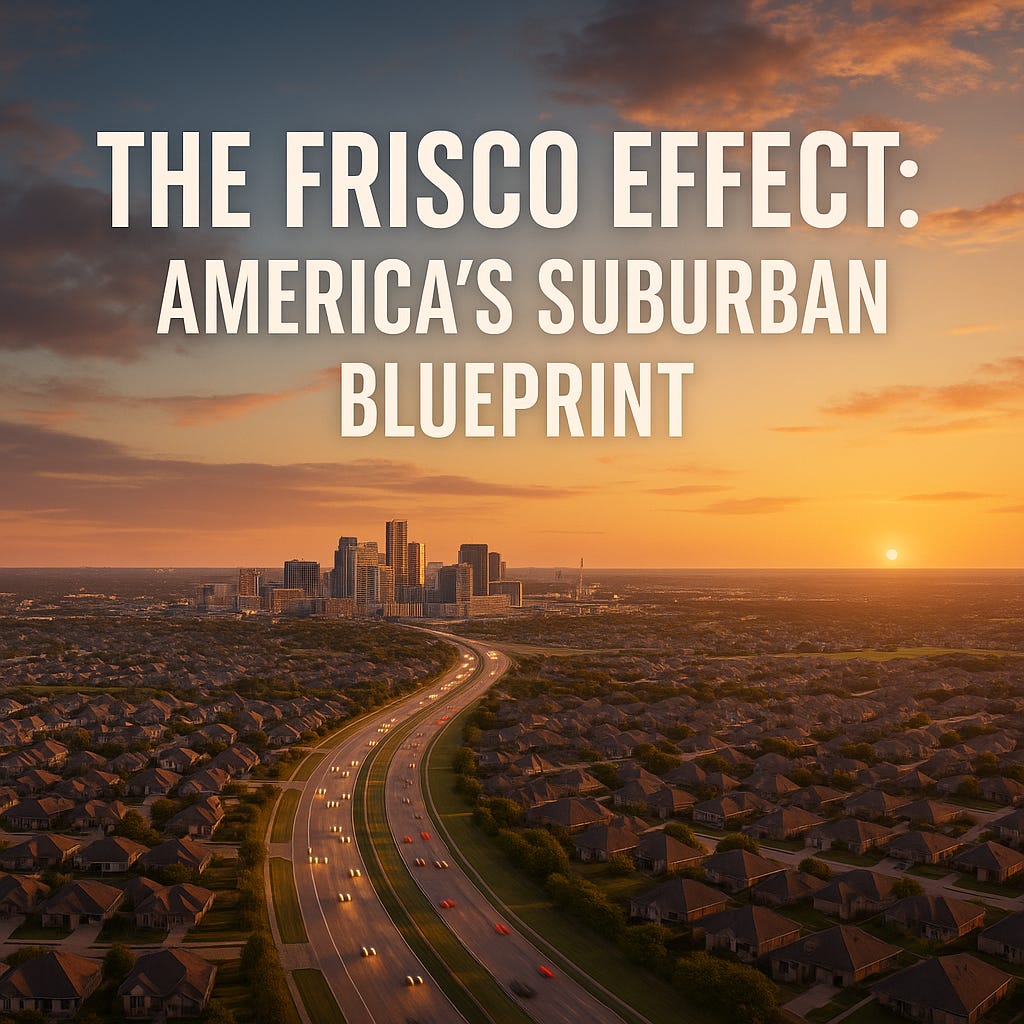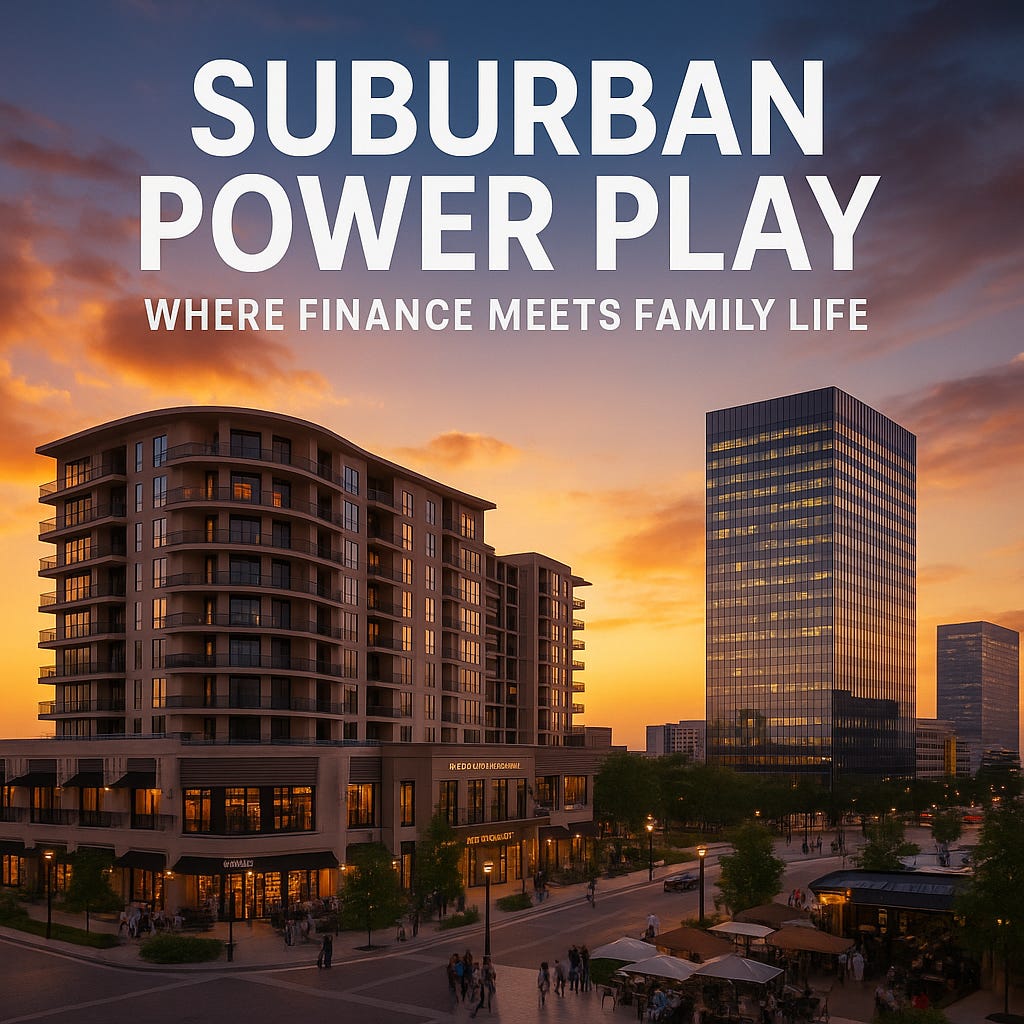🏗️ The Frisco Effect: How North Texas Suburbs Became America’s Growth Playbook
America’s Suburban Blueprint is designed after a popular North Texas community.
If you want to see the future of American suburbia, start with a Frisco building permit.
North Texas didn’t just survive the last two decades of growth — it wrote the playbook. What began as a few master-planned communities and a football stadium has become a full-blown economic engine, shaping how the country thinks about suburban development, retail clusters, and public-private partnerships.
Today, Frisco stands as the poster child of what happens when business, education, and infrastructure align perfectly — and its neighbors are racing to copy the formula.
Frisco: from farmland to Forbes cover story
Two decades ago, Frisco was mostly cornfields and optimism. Now it’s the home of the Dallas Cowboys’ Star District, PGA of America headquarters, and a skyline that glows with cranes and LED signage.
Every national developer has a project in play here — office, mixed-use, retail, multifamily, you name it. And because every “next Frisco” wants to be Frisco, the ripple effects have become a development gold rush.
As one local broker put it, “If you see orange cones, it’s probably a new Starbucks or a new school — either way, value just went up.”
The northward migration: Princeton, Celina, Anna, Melissa
Drive north of U.S. 380 any weekend and you’ll see the new frontier — Princeton, Celina, Anna, Melissa — cities once known only to locals now being studied by institutional developers.
Celina was recently the fastest-growing city in America.
Princeton is now taking that title, adding thousands of rooftops per year.
Sherman is poised to become the next industrial and tech hub thanks to Texas Instruments’ new semiconductor plant.
Add in the Outer Loop Project, which will eventually link these communities in a ring of high-speed mobility, and you’ve got a suburban super-corridor in the making.
We used to joke that “Frisco was the end of civilization.” Turns out, it was just the start of a much bigger one.
Retail follows rooftops — and rooftops won’t stop
The formula is simple:
Population surge → retail demand
Retail demand → commercial land grabs
Commercial development → community identity
As of 2025, new retail centers are already being entitled in Celina, Anna, and Princeton, with anchor tenants chasing rooftops like it’s 2005 all over again. Restaurants, childcare centers, dental offices, boutique gyms — the entire small-business ecosystem is arriving in lockstep.
And because so many of these new residents are relocating professionals from corporate and tech backgrounds, they bring disposable income, entrepreneurial spirit, and — importantly — spreadsheets.
Half of our “new landlords” used to work at places like JPMorgan Chase or Toyota. They understand ROI better than they understand irrigation, but they’re learning fast.
Infrastructure = inevitability
Nothing fuels commercial real estate confidence like concrete.
The Outer Loop, 121 expansion, and the Dallas North Tollway extension have turned once-remote land tracts into instant opportunities.
Meanwhile, developers are taking a longer-term view: planning mixed-use town centers, medical corridors, and entertainment districts that mirror Frisco’s balance of lifestyle and commerce.
It’s not just growth — it’s intentional urban planning wearing cowboy boots.
Why this matters nationally
North Texas isn’t unique because it’s growing fast — it’s unique because it’s growing smart. Cities like Nashville, Phoenix, and Charlotte are studying how Collin and Denton counties have leveraged infrastructure and branding to build sustainable, desirable communities.
If “build it and they will come” was the old mantra, ours might be:
“Zone it right, and they’ll stay forever.”
The new suburban investment thesis
For investors, the message is clear:
Retail land along the 380 corridor is undervalued — for now.
Office condos and service-based flex spaces will boom next.
Build-to-rent and medical retail will be the new darling asset classes.
There’s no better laboratory for the future of CRE than the stretch between Frisco and Sherman. If you want to see where small investors become developers and developers become legends, this is the place.
Our take: the Frisco Effect is just getting started
We used to call these “bedroom communities.” Now they’re boardroom communities — self-sustaining, tech-driven, and flush with ambition.
The Frisco Effect isn’t just about one city — it’s the story of a region teaching America how to grow responsibly, profitably, and proudly.
Because here in North Texas, we don’t just build subdivisions.
We build momentum.


